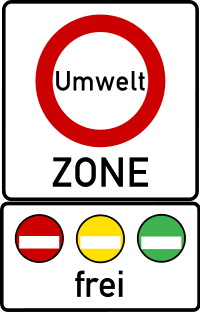Low-emission zone

A low-emission zone (LEZ) is a defined area where access by some polluting vehicles is restricted or deterred with the aim of improving the air quality. This may favour vehicles such as (certain) alternative fuel vehicles, hybrid electric vehicles, or zero-emission vehicles such as all-electric vehicles.
A zero-emission zone (ZEZ) is a LEZ where only zero-emission vehicles (ZEVs) are allowed. In such areas, all internal combustion engine vehicles are banned; this includes hybrid vehicles. Only all-electric vehicles are allowed in a ZEZ, along with walking and cycling and fully electric public transport vehicles, e.g. trams, electric buses etc.
Europe

Over 220 cities and towns in fourteen countries around Europe operate or are preparing low-emission zones,[1] or LEZs, to help meet EU health-based air quality limit values. This means that vehicles may be banned from a LEZ, or in some cases charged if they enter a LEZ when their emissions are over a set level.
Different vehicles may be regulated, depending on local conditions. All LEZs apply to heavy vehicles, some to diesel vans, others also to diesel and petrol cars; in Italy, motor cycles and three-wheelers are also liable to control.
A publicly funded website run by a network of cities and ministries operating or preparing LEZs gives up-to-date information on LEZs, such as which cities have LEZs, the vehicle types affected, the required emissions standards and their application dates.[2]
Belgium
- Antwerp: From the 1st of February 2017, there will be an LEZ will be active in the city of Antwerp, 24/7. Only Diesel vehicles above Euro 3/III norm and Petrol vehicles above Euro 1/I norm will be allowed to enter the LEZ.[3]
- Brussels: From the 1st of January 2018, the entire Brussels Capital Region will become an LEZ.[4] Only Diesel vehicles above Euro 2/II norm will be allowed to enter Brussels.
No restriction will apply to petrol or gas-powered vehicles until 2019, where vehicles will need to be Euro 2/II or more.[5] - Ghent will introduce a LEZ on 1 January 2020.[6]
Germany
In Germany, an LEZ is called an environmental zone (Umweltzone). There are currently 47 LEZs in operation or in planning in Germany.[2] The cities of Berlin, Cologne and Hanover started LEZs in their respective central city areas on 1 January 2008. LEZs also came into effect in the cities of Mannheim and Stuttgart on 1 March 2008. More cities followed in the years after.[7][8][9][10][11]
Sweden
The cities of Gothenburg, Lund, Malmö, Helsingborg, Mölndal, Uppsala, Umeå and Stockholm have low-emission zones.[12] Heavy trucks and buses with compression ignited engines (mainly Diesel engines) may not be allowed inside the environmental zones depending on their age and on their emission class. [13]
United Kingdom
The Mayor of London announced establishment of a low-emission zone which came into effect on 4 February 2008 covering almost all of Greater London - the largest such zone in the world. London currently has levels of air pollution among the worst in Europe and road transport related emissions account for around half of total emissions of PM10 and NOx in the capital. The Low Emission Zone will target emissions of these pollutants from older diesel-engined lorries, buses, coaches, vans, minibuses and other heavy vehicles that are derived from lorries and vans such as motor caravans and motorised horse boxes. There will be a phased introduction of the scheme from 4 February 2008 through to January 2012. Different vehicles will be affected over time and increasingly tougher emissions standards will apply.[14]
Norwich[15] and Oxford[16] have also introduced low-emission zones.
Netherlands, Denmark and Italy
The Netherlands, Denmark and Italy also have LEZs. The Netherlands for heavy goods vehicles, Denmark for vehicles over 3.5T and Italy for all vehicles.[2]
Elsewhere
Hong Kong
Since the end of 2015, the Hong Kong Government has designated three major junctions in Central, Causeway Bay and Mong Kok as low emission zone for franchised buses. For bus routes entering the three zones, franchised bus operators are required to use only buses meeting emission standards of Euro IV or above except when necessary. The LEZ scheme does not cover vehicles other than franchised buses.[17]
See also
References
- ↑ "Archived copy". Archived from the original on 2016-12-02. Retrieved 2016-04-12.
- 1 2 3 "Low Emission Zones". Lowemissionzones.eu. Retrieved 2015-02-21.
- ↑ "Antwerp LEZ". Stad Antwerpen. Retrieved 2017-03-08.
- ↑ "La LEZ (Brussels LEZ-map)". Brussels Capital Region. Retrieved 2017-03-08.
- ↑ "Mon Véhicule (Table of allowed Vehicles)". Brussels Capital Region. Retrieved 2017-03-08.
- ↑ "Lage-Emissiezone". Stad Gent. Retrieved 2017-07-13.
- ↑ Archived January 24, 2009, at the Wayback Machine.
- ↑ Stadt Köln. "Cologne City Low Emission Zone - Stadt Köln". Eb.archive.org. Archived from the original on 2008-06-04. Retrieved 2014-01-26.
- ↑ (PDF) https://web.archive.org/web/20090219135400/http://www.hannover.de/data/download/h/Heft_Umweltzone_GB.pdf. Archived from the original (PDF) on February 19, 2009. Retrieved February 18, 2016. Missing or empty
|title=(help) - ↑
- ↑ http://www.presse-service.de/data.cfm/static/686716.html. Retrieved February 2, 2008. Missing or empty
|title=(help) - ↑ "Urban Access Regulation in Europe". Retrieved 21 December 2016.
- ↑ "Miljözoner". Retrieved 12 January 2017.
- ↑ "Emissions standards". Transport for London. Retrieved 2007-11-21.
- ↑ https://laqm.defra.gov.uk/documents/Norwich_lez.pdf
- ↑ https://www.oxford.gov.uk/info/20216/air_quality_management/208/oxfords_low_emission_zone_lez
- ↑ Government sets up franchised bus low emission zones starting today Archived February 2, 2016, at the Wayback Machine.
External links
- Low-emission zones in Europe
- London low emission zone (LEZ)
- TÜV Nord / Germany
- Low Emission Zone
- "BBC NEWS | England | London | £200 pollution charge for lorries". News.bbc.co.uk. Retrieved 2014-01-26.
- Low-emission zones in Germany / emissions-control windscreen sticker
- Berlin's Environmental Zone Information for Foreign Tourists